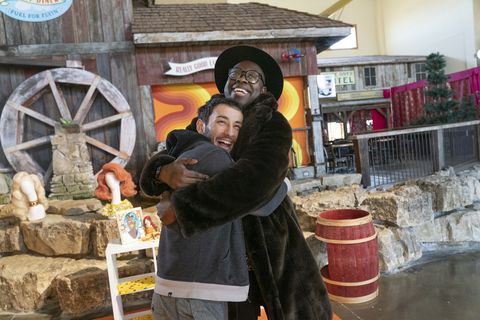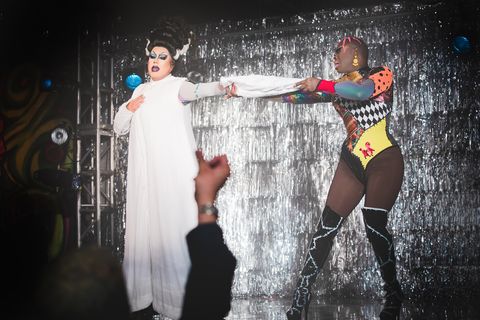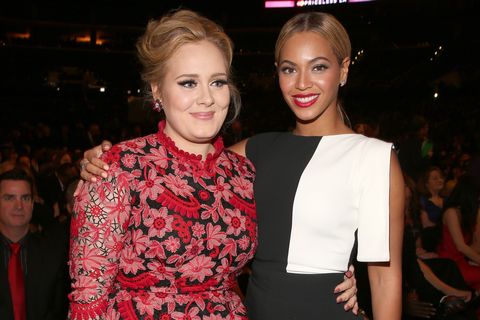As we begin a somber Pride Month, mourning the tragic deaths of Breonna Taylor and George Floyd at the hands of police and enduring the daily challenges of a pandemic, HBO’s We’re Here feels more urgent than ever.
The moving docuseries, created by Stephen Warren and Johnnie Ingram, is more than just three divas—Bob the Drag Queen, Shangela Laquifa Wadle, and Eureka O’Hara—enlisting drag daughters they’ve never met to put on drag shows in what feel like the smallest, most intolerant towns in America. It’s more than just making these folks feel beautiful on the stage, or beating their faces to perfection. We’re Here is a much-needed light, a reminder that in these dark times, in places such as Branson, Mo. or Twin Falls, Idaho, where people may feel the most alone, they’re not and never were.
But most importantly, We’re Here‘s premise isn’t to win over the bigoted, “hate the sin, not the sinner” crowd with feel-good makeovers, tears, and hugs. The show’s primary goal is to empower its LGBTQ guests and their allies in the hope that these messages of acceptance and self-love trickle down to others.
In the six-part series, Bob the Drag Queen, the winner of RuPaul’s Drag Race season 8, is a force, exuding biting humor, boisterous laughter, and an always inviting stage presence. As the first season of We’re Here comes to an end, Bob spoke with ELLE.com about celebrating rural members of the LGBTQ community, his fear of visiting small towns as a black man in America, and how drag saved his life.
I was initially worried We’re Here was going to be all “let’s hug the deplorables,” but thankfully, it’s nothing like that.
At all! There have been other shows that focus on queer people making straight cisgender white people’s lives better, and I was pretty adamant I didn’t want that. We’re going to do queer stories—Latinx, trans, Black, and Indigenous—and it would not be “gays save the world.” And it wasn’t. This is HBO now. [Laughs]
This content is imported from YouTube. You may be able to find the same content in another format, or you may be able to find more information, at their web site.
What has the response to the first season looked like?
People told us the show helped them so much. Being at home with their families during quarantine, they watched it together and for the first time, they could talk about the queer stuff they never talked about before. See, for some queer people, their families see queerness as a deviant life, or refuse to acknowledge the queer side of their loved one. I have had those same experiences, so to hear that this show has helped change that is amazing.
We’re Here focuses on LGBTQ communities that rarely get the spotlight. It’s nice to see what it means to be queer outside of New York, LA, Chicago, or Miami.
I’m queer and from a small town, and I was one of those folks who felt they needed to be invisible because I felt invisible—and I was in the theater program! [Laughs] So if you can feel invisible in a theater program, what about the folks who work at the car factory or the military base. How did they feel? Imagine them realizing there are drag queens [and other queer folks in their town]. These stories matter.
The episode with Tanner, the Christian man from Branson, Mo., who was trying to repress his sexual orientation because of his religion, was one of the hardest for me to watch.
I had a very similar journey with my queer mother. One day my mom came out to me and then one day in high school, she randomly stopped being queer. At the time, I was coming into my queerness, and here she is telling me, “I’m not queer anymore.” And I asked myself, “What does this mean for me?” I could relate to his struggle. Recently, I was really in my feelings because I watched this review of the show that said I was not emotionally equipped to support the people we are helping.
They must not be watching the same show as the rest of us. I’ve seen you in tears during some of these episodes.
TEARS! What some people may not see is how hard we work behind the scenes. Shangela, Eureka, and I are consulting producers—we are also working our asses off. We don’t just come in for comedic value while someone else does all the hard work. We come up with these numbers and sew our costumes.
I can’t lie—every episode, when y’all make your entrances into these predominately white small towns for the first time, my anxiety level is high. But especially for you, a tall, dark-skinned Black man—were you afraid at all?
Maybe in the beginning. When people see me, whether they see me as me or in drag or regardless of my weight of 230 pounds, they see a big Black man because I am a really big Black man. I was talking to one of my closest friends about the episode where we got the cop called on us three times for walking down the sidewalk. Remember, the man came out and told us, “You need to leave. You need to get off the premises.” Listen, when white folks use the words “premises” and “my property,” bitch, shit is gonna get real and I don’t fuck around with that. Meanwhile, my friend was like, “Well, what did the police do?” Do you think my black ass stayed around long enough to see what the cops did? I left. [Laughs]
I know I wasn’t doing anything wrong, but in times like that, I get really nervous. That’s the fear of being Black in America. Even when you haven’t done anything wrong, it’s a double-edged sword, because you want to defend yourself, but you are constantly seeing images of us being killed. And so now we’re afraid of cops.
This content is imported from Twitter. You may be able to find the same content in another format, or you may be able to find more information, at their web site.
You’re not one to hold back about racism, especially within the Drag Race fandom. I mean your Twitter name is “Black Lives Still Matter.” Why is being so vocal important to you?
I am a loudmouth. [Laughs] Recently, me and Peppermint—she was on season 9 [of Drag Race] and the first trans person to ever have a major role in a Broadway show—were having a talk about racism in the Drag Race fandom and how that fandom is a microcosm of the real world. Black queens don’t have followings as big as our white counterparts and being harassed is part of what is happening out there.
In the first episode, you shared that drag saved your life. How?
Drag is what led me to recognize my gateway into the queer community. In Columbia, Georgia, I was around a bunch of straight people and othered, and no one around me had anything in common. But in drag, I was celebrated for all the things I was told were not good about me. I remember watching BeBe Zahara Benet, the season 1 winner of Drag Race, and seeing BeBe celebrated for being black, femme, and queer. Those were positive things. It wasn’t, “We love you in spite of these things.” It was, “We love you because of those things.” Yes, there are plenty of issues within the queer community, but the people in my life, the people I surround myself with in drag, were telling me I was good. That saved me.
This content is created and maintained by a third party, and imported onto this page to help users provide their email addresses. You may be able to find more information about this and similar content at piano.io
This commenting section is created and maintained by a third party, and imported onto this page. You may be able to find more information on their web site.






